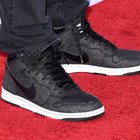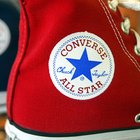
Jordans are short for "Air Jordans", a particular line of Nike sneaker that debuted in 1984, named after the famous basketball player, Michael Jordan. In 1984, however, Michael Jordan was still a rookie player, and the Nike, struggling at the time, paid him to endorse their product. The colors, with Michael Jordan's endorsement, made them nearly an overnight sensation. Nike continues to make cutting edge styles of sneakers in this line and their desirability causes imitators to continue to make imposters. When examining a prospective pair of Air Jordans, it pays to be able to authenticate them on the spot.
Look inside the shoe and find that inner tag that states where the shoe was made. Real ones are made in China. Fake shoes might say a Southeast Asian country, like Taiwan.
Examine the jumpman logo. Different lines of air Jordan position him in various places on the shoe, however, wherever he is, he should be centered with the basketball he's holding pointing straight up.
Bring a picture of an authentic pair of Air Jordans that matches the pair in question. Check the shoe for color matches throughout all areas of the sneaker. An authentic shoe will show the correct details of the shoe: the laces, the jumpman, the toe, the heel the cuff in the correct colors. A fake shoe will make some mistakes. For example, it may have a tan jumpman logo when it should be red.
Compare the shoe in question with your picture once more. Check the shoe for very subtle patterns and textures that the authentic shoe will have. For example, a small patch of the shoe might be mesh. A real shoe will replicate that mesh pattern perfectly. A fake shoe may or may not have such details, but if it does, the texture or pattern will not be a perfect replica.
Ask to see the box the shoe came in. Authentic shoes will have a perfectly sized box in pristine condition. Check the logos and the jumpman on the box: the colors should be bright and perfect; the jumpman and logos should be centered. Faint, bleeding colors are signs of a fake.
Related Articles

How to Tell a Fake Nike Shoe

How to Tell Real Shoes Like Airforce ...

How to Tell if Converse All-Stars Are ...

How to Spot Fake Puma Shoes

How to Tell an Authenic Birkenstock ...

How to Spot Fake Vans

How to Tell Fake Coogi Pants From the ...

How to Spot Fake Chuck Taylors

The Difference Between Nike Dunks & AF1

How to Tell if Nike SB Dunks Are Real

How to Tell the Difference Between Fake ...

How to Tell if a Baseball Jersey is ...

How to Spot Fake Polo Shoes

How to Tell if Vans Are Real

How to Authenticate Gucci Belts

How to Identify Authentic Christian ...

How to Dress Like Travis Barker

How to Spot Counterfeit Tommy Hilfiger

How to Spot Fake Nike Air Force One ...

How to Identify Ralph Lauren Labels
References
- "Just Do It: the Nike spirit in the corporate world; Donald R. Katz; 1994
- "Vibe"; Ya Smell Me; Dec 2005
- Nike: Air Jordan History
Writer Bio
Lane Cummings is originally from New York City. She attended the High School of Performing Arts in dance before receiving her Bachelor of Arts in literature and her Master of Arts in Russian literature at the University of Chicago. She has lived in St. Petersburg, Russia, where she lectured and studied Russian. She began writing professionally in 2004 for the "St. Petersburg Times."
Photo Credits
Jack Hollingsworth/Digital Vision/Getty Images